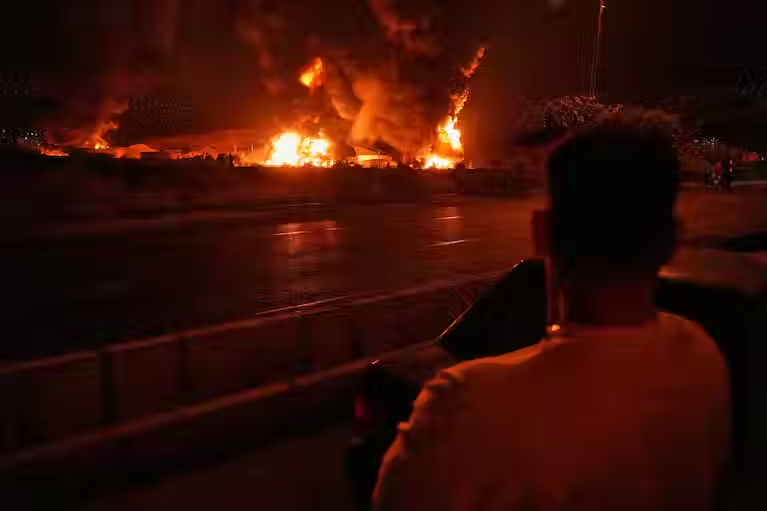The Escalation, Aftermath, and Human Cost of the 2025 U.S. Strikes on Iran’s Nuclear Program
- Legally Speaking
- 3 minutes ago
- 3 min read

Written by Aaron Thomas on July 16, 2025.
On June 21–22, 2025, the U.S. launched a major attack on Iran’s top three nuclear sites, escalating tensions with Iran and Israel and complicating international diplomacy.
In the weeks before the June 2025 bombing, tensions between Israel and Iran soared after Israel unexpectedly attacked Iranian nuclear and military sites, asserting it was a necessary move to stop Iran from developing nuclear weapons. Iran responded with rocket and drone assaults on Israeli targets, leading to casualties and a dangerous escalation of hostilities. This urgent crisis had deep roots in decades of mistrust and conflict that trace back to the 1979 Iranian Revolution. Over the years, relations between the U.S. and Iran have been fraught with crises, sanctions, proxy wars, and military confrontations. These include the 2020 U.S. drone strike that killed Iranian General Qasem Soleimani, each incident further complicating efforts to curb Iran’s nuclear ambitions.
To note, The U.S. has long seen Israel as a key ally in the Middle East, especially in countering Iran’s nuclear ambitions. Fast-forward to now, Israel’s offensive against Iranian targets on June 13 and Iran’s retaliatory strikes, tensions rose, increasing regional instability. In response, the U.S. launched Operation Midnight Hammer, targeting Iran’s nuclear sites at Fordow, Natanz, and Isfahan to weaken its nuclear program and prevent further escalation. This action heightened concerns about a broader conflict, especially as Iran warned of “lasting repercussions.” U.S. officials called the operation a “remarkable success” that “severely damaged the Iranian nuclear program,” but independent experts and satellite images suggested otherwise. They indicated that Iran’s nuclear efforts were not fully dismantled and that some uranium stockpiles likely remained intact. Iranian Foreign Minister Abbas Araqchi condemned the strikes as “outrageous,” calling them a “serious breach of the international nuclear Non-Proliferation Treaty” and warning of long-term consequences.
The humanitarian and psychological toll from the U.S. bombing of Iran’s nuclear facilities continues to grow. Since the strikes, Iranian hospitals have reported more than 120 civilians injured and at least 34 deaths due to missile debris and secondary explosions near Isfahan and Natanz. Humanitarian organizations warn that if the conflict intensifies, up to 1.5 million people in central Iran could be displaced. Additionally, the World Food Program anticipates a 40% increase in food insecurity across the most affected regions. The International Crisis Group has issued a warning that a full-scale regional war could swiftly escalate, risking over 50,000 casualties within a few months due to the presence of advanced weapons on both sides and the vulnerability of densely populated urban areas.
The physical devastation is only part of the story; the psychological toll has been just as devastating and widespread. According to the Iranian Red Crescent, mental health emergencies in clinics in Isfahan and Qom have surged by 300%, as families seek refuge in underground shelters, overwhelmed by uncertainty and fear for their safety. The destruction of vital infrastructure and the threat of further violence have left entire communities deeply traumatized, with many families torn apart and uncertain if they will ever see their homes again. As The Guardian reported, “If the cycle of retaliation continues, we could see a humanitarian disaster on a scale not witnessed in the region since the Iraq War, with civilian populations bearing the brunt of military escalation and basic infrastructure at risk of total collapse.”
The June 2025 U.S. strikes on Iran’s nuclear sites show the heart of American policy. The U.S. aims to stop Iran from getting nuclear weapons, using military force if diplomacy does not work. The U.S. called Operation Midnight Hammer crucial for security in the region and the world. However, the strikes happened without Congress’s approval and closely followed Israel’s lead. This raises important questions about the use of preventive force and respect for legal and diplomatic rules. The aftermath brought civilian suffering and led Iran to stop cooperating with nuclear inspectors. U.S. policy now faces a tough challenge: prevent nuclear proliferation, avoid humanitarian crises, and keep the door open for diplomacy.
When countries take the gamble of going to war, the toll isn’t just in military tactics, but in broken lives and the constant threat of disaster lurking in the shadows.
What Should We Consider:
Will the U.S. strikes on Iran’s nuclear sites lead to a prolonged regional war or remain a limited conflict?
What are the long-term implications for the global nuclear non-proliferation regime?
The International Crisis Group has warned that a full-scale regional conflict could result in over 50,000 casualties within months. Knowing this, how likely is this scenario, and what would the humanitarian impact be?
Could the strikes inspire other regional powers to pursue or accelerate their own nuclear programs, triggering a wider arms race in the Middle East?






Comments